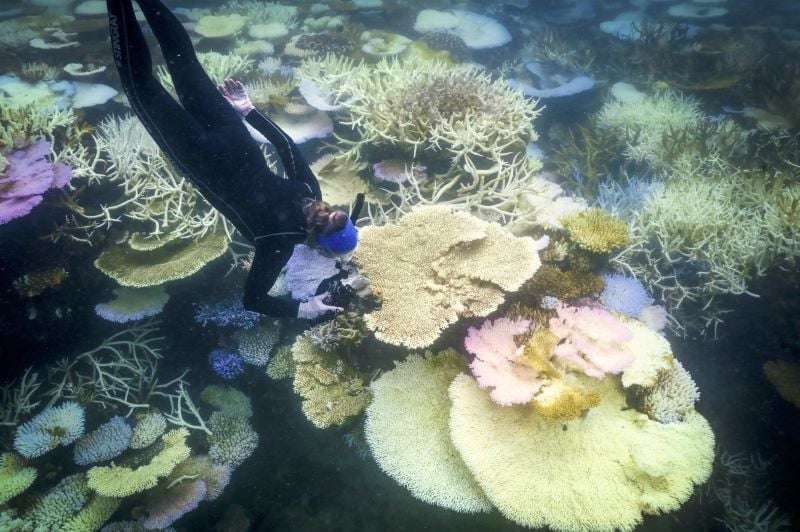Overview of Coral Mortality in the Great Barrier Reef
Introduction
The Great Barrier Reef, one of the world’s most diverse marine ecosystems, is facing unprecedented coral mortality. Recent climatic events, including mass bleaching, cyclones, and flooding, have exacerbated the situation, leading to significant coral deaths. This article delves into the recent findings by the Australian Institute of Marine Science (AIMS), highlighting the extent of damage and the challenges ahead.
Current State of the Great Barrier Reef
Recent Surveys and Findings
Between August and October, researchers from AIMS conducted extensive in-water surveys across 19 reefs, from Lizard Island to Cardwell. The results were alarming, with up to 72% coral mortality recorded on 12 of the reefs surveyed. The northern section, spanning from Cooktown to Lizard Island, experienced a loss of over a third of its hard coral cover. This decline marks the largest annual reduction in coral health since government monitoring began 39 years ago.
Causes of Coral Mortality
The significant coral mortality is attributed to several factors:
- Mass Bleaching Events: Increased sea temperatures have led to frequent and severe bleaching events.
- Tropical Cyclones Jasper and Kirrily: These cyclones caused physical damage to the coral structures.
- Freshwater Flooding: Intense flooding between December 2023 and March 2024 contributed to the coral stress and subsequent mortality.
Impact of Climate Change on Coral Health
AIMS scientists emphasized the increasing frequency, footprint, and intensity of bleaching events due to climate change. Manuel Gonzalez Rivero, AIMS Acting Research Programme Director, stated, “These initial results show the vulnerability of the Reef to bleaching events. Its resilience is being severely tested.”
The Ecological Importance of the Great Barrier Reef
Biodiversity and Marine Life
The Great Barrier Reef spans approximately 2,300 kilometers (1,429 miles) off Australia’s northeastern coast. It is one of the world’s most species-rich habitats, home to:
- Hundreds of coral species
- Over 1,600 fish species
- 133 types of sharks and rays
- 30 species of whales and dolphins
Bleaching and Its Effects
Bleaching occurs when rising water temperatures stress the coral, causing it to expel zooxanthellae, the microscopic algae that live in their tissues. This process leaves the corals white and, if prolonged, can result in their death. The current year has already witnessed the fifth mass bleaching event in just eight years, with the highest death rate observed among the fast-growing coral species, Acropora.
Research and Observations
Lead researcher Mike Emslie described the past summer as “one of the most severe events” across the Great Barrier Reef, with heat stress levels surpassing previous records. “These are serious impacts. These are serious losses,” he told Australia’s ABC.
Future of the Great Barrier Reef
Potential for Recovery
Richard Leck, head of oceans for WWF-Australia, expressed his concerns, stating that the initial survey results confirmed his “worst fears” for the reef’s future. While the Great Barrier Reef has the potential to recover, repeated stress events limit its resilience. Leck warned, “We are fast approaching a tipping point.”
Calls for Action
Leck urged Australia to commit to stronger emission reduction targets. He advocated for a minimum 90% cut from 2005 levels by 2035 and a shift away from fossil fuel dependency. Despite recent steps toward carbon neutrality, Leck argued that more ambitious actions are necessary to safeguard the reef’s future.
Strategies for Conservation and Recovery
Emission Reduction Targets
Reducing greenhouse gas emissions is crucial for mitigating the impacts of climate change on coral reefs. Achieving significant emission reductions requires a comprehensive approach, including:
- Transitioning to renewable energy sources
- Implementing energy efficiency measures
- Promoting sustainable land use practices
Enhancing Coral Resilience
Efforts to enhance coral resilience include:
- Restoration Projects: Active restoration projects, such as coral planting and reef rehabilitation, can help regenerate damaged areas.
- Marine Protected Areas (MPAs): Expanding MPAs to provide safe havens for marine life and promote biodiversity.
Community and Government Initiatives
Collaborative efforts between communities, governments, and organizations are essential for effective conservation. Initiatives could include:
- Education and Awareness Campaigns: Raising awareness about the importance of coral reefs and the threats they face.
- Policy and Legislation: Implementing policies that protect marine environments and regulate activities that harm coral reefs.
Conclusion
The Great Barrier Reef is at a critical juncture, with recent climatic events causing unprecedented coral mortality. While the potential for recovery exists, it is contingent upon immediate and sustained efforts to reduce emissions and enhance coral resilience. Protecting this natural wonder requires a concerted effort from all stakeholders, including governments, organizations, and communities.
FAQs
What are the main causes of coral mortality in the Great Barrier Reef?
The main causes include mass bleaching events, tropical cyclones, and intense freshwater flooding.
How does bleaching affect coral reefs?
Bleaching occurs when corals expel the algae living in their tissues due to stress from rising water temperatures, leading to a loss of color and potentially resulting in coral death.
What species are most affected by bleaching?
The fast-growing coral species, Acropora, is particularly vulnerable to bleaching and has shown the highest death rates in recent events.
What actions can be taken to protect the Great Barrier Reef?
Actions include reducing greenhouse gas emissions, implementing coral restoration projects, expanding marine protected areas, and promoting sustainable practices.
Why is it important to protect the Great Barrier Reef?
The Great Barrier Reef is one of the world’s most biodiverse ecosystems, providing habitat for a wide range of marine species and offering significant ecological, economic, and cultural benefits.


